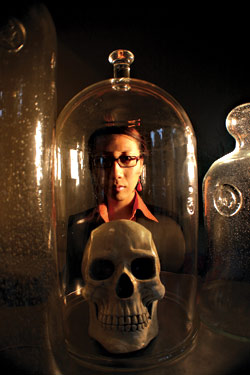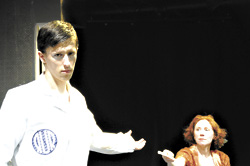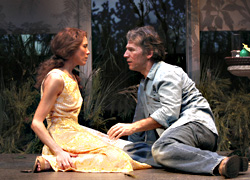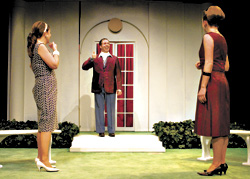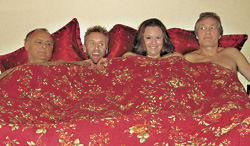“The eyes that fix you in a formulated phrase,” wrote T.S. Eliot in The Love Song of J. Alfred Prufrock. “And when I am formulated, sprawling on a pin/When I am pinned and wriggling on the wall/Then how should I begin/To spit out all the butt-ends of my days.” Such a lovely metaphor: a man trapped in another’s preconception, frozen like a bug in the amber of a rigid idea, unable to assert his full, unreconstructed self. That, in a nutshell, is the driving philosophy behind The Museum Play, a new work by Jordan Harrison premiering at Washington Ensemble Theatre’s Little Theatre. Directed by WET co–artistic director Marya Sea Kaminski, the play is a hybrid of The Twilight Zone and early Kurt Vonnegut, a sort of ironic-absurdist meditation on untenable sentiments and immortal longing. Harrison (Finn in the Underworld, Act a Lady) is a young playwright who’s had a lot of early success; his work is vibrant and fresh, and if his ideas are still a bit untamed and sprawling, there’s enough energy and intelligence in this play to fix your eyes to the stage.
The story is simple in its elements, its plot skeletal. Jame (Marc Kenison), a curator at a museum of natural history with a penchant for sizing up the artifactual elements of things, is in love with Vin (Lathrop Walker), a striking boy with perfect bone structure. Vin, however, looks upon their romance as a “college” thing, an experiment that holds no promise for the future. In a hilariously uncomfortable scene, Jame is waxing poetic about museum matters when Vin stops him to pull his new flame, Lila (Elise Hunt), into the bedroom. The awkwardness that ensues is well-written, with a comic naturalism that takes the harder road of showing each character trying to accommodate the other.
Beyond the bedroom, the majority of the stage is taken up by the titular museum, a sort of musty funhouse of dark corners and display cases full of pinned butterflies and creepy looking dioramas. Apparently the museum carries some kind of Hotel California/House of Usher curse: nobody who works there seems capable of escaping this dead/living museum, with its occasionally moving displays and butterflies crawling the walls. The Head Curator (Mikano Fukaya, reprising once again the brash, robotic role she seems always to play in WET productions) addresses the audience, leading the tour through this house of wonders and horrors. But it’s Lucy (the excellent Patricia Nelson), the tetched security guard, who seems most affected by the strange goings-on in the museum; in her opening scene, she stands with a stricken look on her face, repeating in crescendo the phrase, “I am sick of all these stupid questions.” Apparently, Lucy has spent her entire life in the museum, never going outside—never even considering the possibility. It’s that kind of place.
Kaminski does a superb job of orchestrating the myriad philosophical and macabre elements Harrison lards into the script. The action zips along, and there are a number of stunning scenes; most affecting is the moment when Jame traps Vin (through love, of course) behind the glass of a display case, turning his former lover into an artifact frozen at the moment of seduction. It’s a truly creepy scene, full of pathos and terror, played with just the right amount of humanity to avoid a schmaltzy result. Also notable is veteran actor/playwright/director Michael Brill in the wonderfully realized dual role of a wandering tourist and Mr. Everly, the scientist.
The Museum Play is a good (though certainly not great) piece of theater, and in the hands of the folks at WET it seems to achieve its fullest potential. The play never fails to entertain, even when it begins to move in several directions at once, and somehow its competing concerns never tear it apart. One thing’s for sure: It’s a strange and even daring way to open the season, another challenge for both the audience and the company. Neither bang nor whimper, the play falls as a sort of placeholder in what continues to be a strong and interesting run by this young, talented group of artists.
